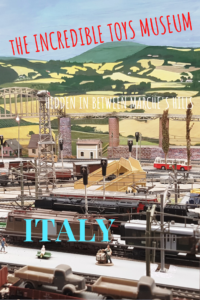Right in between the picturesque hilly landscapes of Marche, we find Museogiocando, an incredible collection of toys from all times, captivating anecdotes, and very lively scale models.
(For an Italian version, scroll down)
It is very well known that playing games always had a fundamental role in peoples lives, be it games for youngs or for adults, to play in solitude or with company. For good reasons, from Plato to Mark Twain, the subject has been tackled by philosophers, writers and poets of every time and culture.

But while playing is inevitably linked to our existence, toys have a much shorter history, which can be dated back to right after the enlightenment, when children started to be emancipated. From the second half of the 19th century, when it became possible to start an industrial-scale production and decrease prices, notably in the United States of America, toys began to spread worldwide.
This was just one of the many anecdotes I could hear from Gianni Catella, founder of Museogiocando, an incredible place, where a jaw dropping in wonder is the only reaction to be expected. It is a miniature world which floats vividly in between our imagination and childhood memories, no matter the generation we are from.

It goes without saying, a big part of the museum is dedicated to model building. There are huge, rigorously hand-made, scale reproductions of landscapes where everything has been studied to the last detail and every train, and not only the trains, moves electrically, passing over bridges, inside galleries, and risking collisions over complex railroad switches. A delight for the eyes of all ages.
Some backgrounds of these scale models represent the beautiful hilly landscapes of the Marche region, the same that can be admired from Piticchio, the typical village-castle where the museum can be found. After a couple of hours of pure joy at Museogiocando, it is possible to take advantage of the amazing views from any of the many medieval hamlets in the area. As usual, gastronomic discovery is also a big plus in Italy, in the area there is no lack of regional restaurants.
Museogiocando exposition is not made of trains and all kind of toys only, one room is entirely dedicated to thousands of car models, some extremely complex to build (over 5,000 parts!). Furthermore, some pieces of the collection have a special story to tell, like ventriloquist Charlie McCarthy’s puppet, which earned an Oscar to his owner.

The final touch is however the anecdotes told by Gianni, who is a wealth of information on the subject. Where else could I have learned that the first dolls made of Bakelite in Victorian England created a scandal, as they faithfully reproduced a human body? Or that Moplen, a kind of plastic material used, among other things, to make the first types of soft dolls, was invented by Giulio Natta, an Italian which then won the Nobel prize in chemistry?
Only at Museogiocando, where a visit is highly recommended for the poetic nostalgia of the museum, the fondness of the owners, and the beauty of this corner of Italy.
And that’s 500 words, let’s go!
Italian Version
L’incredibile Museo del Gioco Nascosto tra le Colline Marchigiane
Nel bel mezzo dei pittoreschi paesaggi collinari delle Marche, si trova Museogiocando, un’incredibile collezione di giocattoli di ogni d’epoca, affascinanti aneddoti, e vivacissimi plastici in scala.
Il gioco, si sa, ha sempre avuto un ruolo fondamentale nelle vite degli esseri umani, che fosse quello dei piccoli o quello degli adulti, quello in solitudine o quello in società. Non a caso, da Platone a Mark Twain, l’argomento è stato trattato da filosofi, scrittori e poeti di sempre e di ogni cultura.
Ma mentre il gioco è inevitabilmente legato alla nostra esistenza, i giocattoli hanno una storia più breve, che si può far risalire all’emancipazione dei bambini avvenuta dopo l’illuminismo. Dalla seconda metà dell’Ottocento, quando diventa possibile produrli in grande scala e a prezzi ragionevoli, i giocattoli si diffondono in tutto il mondo, a cominciare dagli Stati Uniti D’America.

Questo è solo uno dei tanti aneddoti che mi sono stati raccontati da Gianni Catella, ideatore e fondatore di Museogiocando, un luogo incredibile, dove rimanere a bocca aperta è l’unica reazione possibile. Si tratta di un vero e proprio mondo in miniatura, un luogo che vivacemente si frappone tra fantasia e ricordi della nostra fanciullezza, non importa di quale generazione siate.
Non c’è bisogno nemmeno di dirlo, ma gran parte del museo è dedicato al modellismo. Vi sono enormi plastici in scala rigorosamente costruiti a mano, dove tutto è stato studiato nei minimi dettagli ed ogni treno, e non solo i treni, si muove elettricamente passando su ponti, dentro gallerie, e rischiando scontri su complessi scambi ferroviari. Una delizia per gli occhi di ogni età.
Gli sfondi di alcuni plastici riproducono i bellissimi paesaggi collinari delle Marche, quelli che si possono ammirare proprio da Piticchio, un borgo-castello non lontano da Jesi, dove il museo si trova. Dopo un paio d’ore di gioia al Museogiocando ci si può godere una fantastica vista dalle mura di uno dei molti borghi medievali della zona. Come sempre, le scoperte gastronomiche sono un fattore da considerare, e la zona non manca certo di ristoranti con cucina regionale.

A Museogiocando non sono esposti solo trenini ed ogni sorta di giocattoli, una stanza è interamente dedicata a migliaia di modellini di macchine, alcuni estremamente complessi da costruire (più di 5,000 parti!). Alcuni pezzi della collezione hanno una storia particolare, come il pupazzo del ventriloquo Charlie McCarthy, che guadagnò un Oscar al suo proprietario.
Il tocco finale tuttavia sono gli aneddoti di Gianni, che è un pozzo di informazioni sull’argomento. Dove altro avrei potuto imparare che le prime bambole di bachelite creata in epoca Vittoriana fecero scandalo in quanto riproducevano fedelmente un corpo umano? Oppure che il moplen, una materia plastica usata (anche) per fare le prime bambole morbide fu inventato da Giulio Natta, un italiano che poi vinse il premio Nobel per la chimica?
Solo al Museogiocando, dove una visita è raccomandata per la nostalgia poetica del museo, la simpatia dei proprietari, e la bellezza di quest’angolo d’Italia.
E queste sono 500 parole, andiamo!







